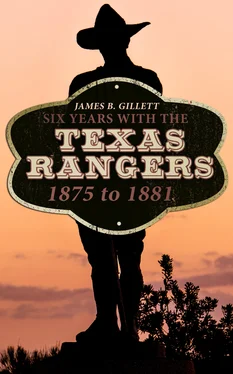James B. Gillett - Six Years With the Texas Rangers - 1875 to 1881
Здесь есть возможность читать онлайн «James B. Gillett - Six Years With the Texas Rangers - 1875 to 1881» — ознакомительный отрывок электронной книги совершенно бесплатно, а после прочтения отрывка купить полную версию. В некоторых случаях можно слушать аудио, скачать через торрент в формате fb2 и присутствует краткое содержание. Жанр: unrecognised, на английском языке. Описание произведения, (предисловие) а так же отзывы посетителей доступны на портале библиотеки ЛибКат.
- Название:Six Years With the Texas Rangers: 1875 to 1881
- Автор:
- Жанр:
- Год:неизвестен
- ISBN:нет данных
- Рейтинг книги:3 / 5. Голосов: 1
-
Избранное:Добавить в избранное
- Отзывы:
-
Ваша оценка:
- 60
- 1
- 2
- 3
- 4
- 5
Six Years With the Texas Rangers: 1875 to 1881: краткое содержание, описание и аннотация
Предлагаем к чтению аннотацию, описание, краткое содержание или предисловие (зависит от того, что написал сам автор книги «Six Years With the Texas Rangers: 1875 to 1881»). Если вы не нашли необходимую информацию о книге — напишите в комментариях, мы постараемся отыскать её.
Six Years With the Texas Rangers: 1875 to 1881 — читать онлайн ознакомительный отрывок
Ниже представлен текст книги, разбитый по страницам. Система сохранения места последней прочитанной страницы, позволяет с удобством читать онлайн бесплатно книгу «Six Years With the Texas Rangers: 1875 to 1881», без необходимости каждый раз заново искать на чём Вы остановились. Поставьте закладку, и сможете в любой момент перейти на страницу, на которой закончили чтение.
Интервал:
Закладка:
Return to peace and the days of reconstruction did not do away with the necessity for the service that could only be rendered by the ranger. Banditry, Indian uprisings and massacres, cattle thievery, all flourished, for the bad man confidently expected the post-war turmoil would protect him from punishment for his misdeeds. He was to be undeceived, for the rangers effectively taught him that they were in the state for the purpose of protecting lives and property, and right royally did they perform that duty. From 1868 to 1873 the ranger companies were gradually reduced from one thousand to about three hundred men.
The Federal Government adopted a most unfortunate policy toward the Indians after the war. The tribes were removed to reservations and rationed as public charges. Unscrupulous dealers, in their desire for gain, illegally sold firearms to the Indians, and whenever a redskin massacred a frontiersman he was sure to capture good weapons, so that they soon became well armed and very expert in handling their new weapons. As no attempt was made to confine them to the reservation limits, the redskins, under their native chiefs, were always sneaking off and raiding West Texas. These marauders stole thousands of horses and cattle, and did not hesitate to murder and scalp the defenseless people along the frontier. Numbers of women and children were carried off as captives, a very small proportion of which were subsequently ransomed. Repeated complaints to Washington brought no redress. Indeed, some of the government officials calmly declared that the Indians were doing no harm—it was white men disguised as redskins that caused the trouble!
In 1874 conditions along the frontier had become so acute that the need for an organized mounted police for the protection of the settlers against the continued Indian raids became apparent. As in the past the state looked again to her rangers. Early in 1874, during the administration of Governor Richard Coke, the first Democratic governor since secession, the Legislature appropriated $300,000 for frontier defense, thus authorizing the formation of the Texas Rangers as now constituted. The governor immediately issued a call for four hundred and fifty volunteers. These were formed into six companies of seventy-five men each. Each of these units was officered by a captain and a first and second lieutenant. The companies were designated A, B, C, D, E, and F, and received the official name of the Frontier Battalion of Texas Rangers. Major John B. Jones of Corsicana, Texas, was commissioned major of the command. At this time the captains received a salary of $100 per month, lieutenants $75, sergeants $50, and corporals and privates $40. Subsequently, as the Legislature continually sliced into the ranger appropriation, the pay of the private was reduced to only $30 a month, a mere pittance for the hazardous service demanded of them.
Early in 1874 the force took the field, and each company was assigned a definite territory along the frontier. Company "A," being the northernmost company, was camped on the main fork of the Brazos River; Company "F," the southernmost, was stationed on the Nueces River. The remaining four companies were posted along the line between the two commands mentioned about one hundred and twenty-five miles apart, so that the battalion of four hundred and fifty men was required to cover a frontier of between five and &ix hundred miles.
Major Jones was a very able commander, and quickly won the confidence of his men and of the people along the border he was sent to protect. The frontiersmen cooperated with him in every way possible, sending runners to the various ranger camps whenever an Indian trail was found or a bunch of horses stolen. During the very first six months of its existence nearly every company in the battalion had had an Indian fight and some of them two or three. This command finally cleared the Texas frontier of the redskins and then turned its attention to the other pests of the state,—thieves, bandits, and fugitives from justice. In this work the ranger rendered service second to none, and became in an incredibly short time the most famous and the most efficient body of mounted police in the world.
Between 1865 and 1883 the Texas Rangers followed one hundred and twenty-eight Indian raiding parties, and fought the redskins in eighty-four pitched battles. During this same period they recovered six thousand stolen horses and cattle and rescued three citizens carried off by Indians. In this period twelve rangers were killed. Despite this record of service, the Legislature at Austin could not always be made to see the advantages,—nay, the necessity,—for a ranger force, and it was continually tinkering with the appropriations for the support of the force. When the appropriation was small the command was reduced to keep within the expenditure doled out by the parsimonious solons, and recruited to full strength whenever the lawmakers could be prevailed upon to increase the annual ranger budget.
By 1885 conditions had changed. Texas was no longer endangered by Indians, for the rangers had done much to convert the red devils into good Indians,—that is, into dead ones. Although the Indians had utterly disappeared from the state, the activities of the rangers did not cease. The white "bad man" who had stirred up the first Indian troubles now began to plunder and murder his own race and indulge in every form of lawlessness. From hunting the murderous redskins the rangers became now stalkers of the man-killers and those who despoiled their neighbors of their property. The local legal authorities could not or would not handle this task themselves, so the rangers were made peace officers and given the right of arrest without warrant in any part of the state. They then became mounted constables to quell disorder, prevent crime and bring criminals to justice and assist the duly constituted authorities in every way possible. This new work was less romantic than the old Indian warfare, but it was every bit as dangerous and as necessary in the building up of the fast developing state. As in every other task assigned him the ranger did his duty fearlessly and well. Between 1889 and 1890 the rangers made five hundred and seventy-nine arrests, among them seventy-six murderers. With the coming of the railroads the rangers began to use them, as they permitted speed and the covering of greater distances than were possible on horseback. Moreover, commands could be dispatched from one part of the state to another as occasion demanded. This greater mobility led to larger usefulness and increasing number of arrests by the ranger forces.
The outbreak of the Spanish-American War found the ranger ready and anxious for service in the defense of the Union. Large numbers of them were enlisted in the world famous Rough Riders.
"I have heard from the lips of reliable rangers," declared General Miles, in speaking of the ranger service in Cuba, "tales of daring that are incomparable. It is indeed too bad that the world knows so little about those marvelous men. There have been hosts of men among the Texas Rangers who were just as nervy as Davy Crockett, Travis, or Bowie at the Alamo."
Thanks to her rangers, Texas is now one of the most law-abiding, most orderly states in the Union. And, today, more than forty-six years since the organization of the battalion, the state still maintains a tiny force of rangers numbering sixty-three officers and men. In 1920-21, the battalion was composed of a headquarters company and Companies A, C, D, E, and F. As in the beginning of its history, the force is stationed along the frontier. The headquarters company, under command of Captain J. P. Brooks, was stationed at Austin and used for emergency calls. Company "A," stationed at Presidio, and commanded by Captain Jerry Gray, patrols the border between El Paso, Presidio, and Jeff Davis Counties and the back country southward. Company "E," Captain J. L. Anders, patrols the line of Presidio and Brewster Counties to the line of Terrell and Val Verde Counties and eastward. Company "F," under Captain W. W. Davis, was stationed at Del Rio and covered the line from Terrell and Val Verde Counties down the river to the line between Maverick, Dimmit and Webb Counties and the back country. Under the command of Captain William Ryan, Company "C" was located at Laredo and patrolled the line of Maverick, Dimmit and Webb Counties to the line of Zapata and Starr Counties and the back country, while Company "D," stationed at Brownsville, under Captain W. L. Wright, patrols from the line of Zapata and Starr Counties down the Rio Grande to its mouth and the adjacent back country.
Читать дальшеИнтервал:
Закладка:
Похожие книги на «Six Years With the Texas Rangers: 1875 to 1881»
Представляем Вашему вниманию похожие книги на «Six Years With the Texas Rangers: 1875 to 1881» списком для выбора. Мы отобрали схожую по названию и смыслу литературу в надежде предоставить читателям больше вариантов отыскать новые, интересные, ещё непрочитанные произведения.
Обсуждение, отзывы о книге «Six Years With the Texas Rangers: 1875 to 1881» и просто собственные мнения читателей. Оставьте ваши комментарии, напишите, что Вы думаете о произведении, его смысле или главных героях. Укажите что конкретно понравилось, а что нет, и почему Вы так считаете.












